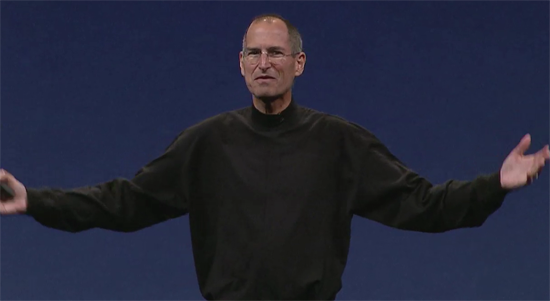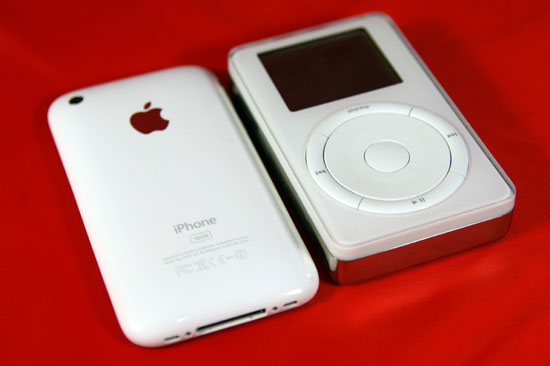Anand Reviews the Apple iPhone 3G
by Anand Lal Shimpi on July 16, 2008 8:00 PM EST- Posted in
- Smartphones
- Mobile
Wait, wait, I know this trick. Steve Jobs gets on stage, announces a new phone, and all of the sudden I’ve got to wait in line for hours to spend money. It’s like World of Warcraft, but less convenient.

Grumble...
We all knew it was coming and once the specs were announced I honestly wasn’t that excited about the iPhone 3G; it seemed like a fairly minor set of updates to the original iPhone.
At the same time, part of what I needed was a reality check. Despite selling very well, most smartphone users still don’t have an iPhone and many haven’t ever used one. Many are scared of the virtual keyboard while others haven’t been able to jump the Windows Mobile ship without better Exchange support from Apple. To the uninitiated, 2008’s iPhone 3G release would be no different than last year’s. Those I was in line with who had never owned an iPhone were just as excited about the 3G model as the people I was in line with last year for the first iPhone.
I also couldn’t help but remember what happened with the first update to the iPod after its release. While the original iPod was amazing, its second generation successor was hardly as impressive. Apple made some much asked-for changes, but moving away from a physical wheel and buttons to touch sensitive controls really hurt the experience for me. I wondered if the second iPhone out of Apple would suffer from a similar repeat of history. The first one was so good that the second one would inevitably be a letdown.

How far we've come
Apple further complicated things by, out of the goodness of its own heart, giving all existing iPhone users free access to the software updates contained within the iPhone 3G. The long awaited 2.0 firmware upgrade, enabling the ability to run 3rd party applications and search contacts among other things. What would’ve otherwise been good reasons alone to upgrade to the iPhone 3G were now given to all iPhone users.
When the iPhone launched we all knew that Apple would have to get the price down to below $200, but the how was what perplexed us. Rumors of smaller versions without a touchscreen were aplenty and despite none of them making any sense, we assumed that it would have to be the route that Apple would take - since that’s how the rest of the cellphone industry works.
It turns out that the cheaper iPhone is nothing more than the iPhone itself, simply subsidized by AT&T. At $499 the iPhone was a must have for any serious smartphone user, at $199 it would seem to be a no-brainer. That is before you take into account increases in the recurring monthly costs that AT&T has snuck into the iPhone 3G launch, but I’ll talk about those later.
There are concerns about size and battery life, users want to know if the new phone is slower, buggier or if the new GPS is actually useful. Then there are the third party applications that launched with the App store, do they enhance the platform or simply make it more amateur? I started this review thinking that it would be short but, much like last year’s iPhone review, the further down the rabbit’s hole I got, the more I realized there was to talk about.
I’m going to take you through much of the new firmware and the new phone. I’m going to talk about battery life, reception and how the Apple/AT&T relationship has changed.
I’m going to talk a lot, it’s what I do, and the subject this year, just as it was last year around this time, is the iPhone.
















55 Comments
View All Comments
sprockkets - Wednesday, July 16, 2008 - link
Yeah, T-Mobile has better coverage than At&t? WTH? Just look at their maps. Do they even have 3G yet?Well, I guess I can trust Anand's experience. But, at least I can take my SIM card out and use my own phone. I guess you can just call Verizon and do the same thing, but with the majority being GSM, there is less of a selection for CDMA.
And of course, Apple is predictable as ever. They advertise every night the iphone on The Daily Show.
cocoviper - Thursday, July 17, 2008 - link
I think as the US and Europe reaches saturation CDMA will become much more competitive. It's what China and Brazil's network are built on, and given the next 10-15 years there will most likely be more cell phone growth and eventually more users there.brzgeek - Wednesday, July 23, 2008 - link
CDMA in Brazil??!! I'm Brazilian, and the last company that was a CDMA holdout (Vivo) gave up that particular battle and switched to GSM about a couple of years ago. Nowadays there isn't a single company selling CDMA phones in Brazil any more (though Vivo still supports CDMA due to its pre-GSM users who haven't switched phones). I suggest you check your sources, they seem to be seriously outdated.NA1NSXR - Thursday, July 17, 2008 - link
You're kidding right? I just spent a year in China and it is a nearly 100% GSM country. I don't even know where you get off saying China is CDMA so matter-of-factly.tayhimself - Wednesday, July 16, 2008 - link
Hmm... this is a great suggestion Anand. Have a yearly charge for both and somehow integrate them too.